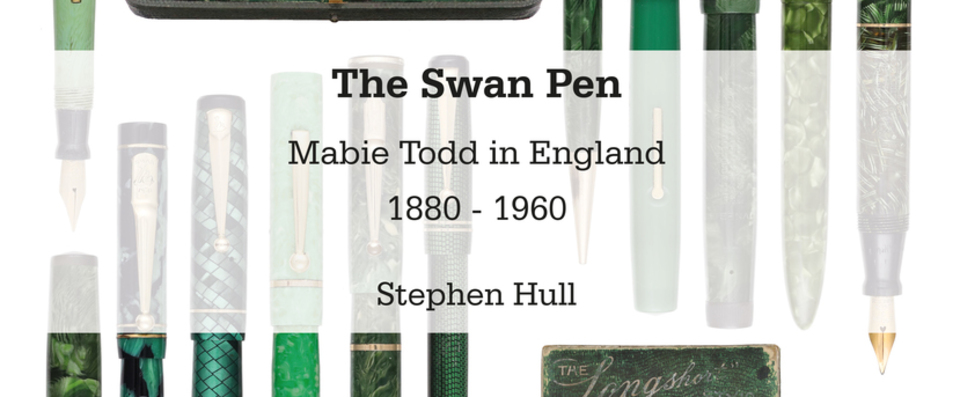
"The Swan Pen - Mabie Todd in England - 1880 - 1960"
By Stephen Huil
Book review by Colin Mackay
This beautiful book by Stephen Hull, premier U.K. pen historian, was launched on 6th October at the Writing Equipment Show in London. It was long awaited, inducing high expectation due to the quality of previous works by the author on the pen makers of England.
Lovers of English Mabie Todd pens (Swan and Blackbird) will find this latest volume an essential read but it is hard to imagine anyone can be more delighted than this reviewer that the book is now available. I first asked Steve Hull about "Swan" reference material when I met him at the Northern Pen Show in Lytham, more than a decade ago. A work, "Mabie in America" became available and a while later, Steve said a UK pens book was possible in the future. Like many more "Swan" collectors, I have asked the question "when?" several times since then.
Here I should explain that my involvement as a user of a "Swan" pen dates back to 1950, when my mother gave me her green "snakeskin Swan". It served me well in my grammar school entrance exam but as an adult I left it in a drawer with other family fountain pens of a similar age. On returning from holiday in 2001, I found our home had been burgled and the pens were gone. The "snakeskin" loss was a greater blow than I first thought and was a recurring disappointment. Eventually, with internet help, I replaced it and began a whole new "late-in-life" interest, Mabie Todd fountain pens, especially "snakeskin" and "lizardskin" examples.
This autumn I could not attend the London WES Show but was in the South of England. On the day after the launch I was happy to be able to collect my limited edition copy from Stephen himself. Mine is number 70 of 72. The 72 copies represent the 72 years since the birth of the Swan in New York in 1887 and its demise in London in 1958. It was twenty-four hours before I was able to open its pages. Immediately I felt I was handling something very special.
"The Swan Pen"'s almost 400 pages, with twelve chapters, cover the history of the brand in its transition from the United States during the late 19th century to the 1920s, through its heyday in the 1930s, wartime struggles and final days in the 1950s. Material has been widely sourced in great depth from trade journals, internal company documents, advertising copy, biographies and technical drawings. This gives the factual foundation but there are human stories too - of American, Charles W. Robinson, who gave us iridium tipped nibs for smooth writing but died almost penniless in a London lunatic asylum, like the making of tiny, 12mm, one twelfth scale working ED pens for Queen Mary's dolls' house, how Gracie Fields, 1930s superstar, loved her "Swan" pen and the acid comments about Biro written by Reginald Phillips (of Oxford Ltd.) as his company continued to supply "Swans" after the collapse of 1958.
Beautiful pens like Swans deserve high resolution photographs. There are over a thousand. The dust jacket, using a green theme, shows thirty-three examples. I was happy to see that I have eleven of them in my collection! There are ED pens, overlays, self fillers, leverless and visofil types. Fyne Poynt pencils, too, are well represented. The technically minded reader will be impressed by a wealth of technical drawings. Throughout this book's story of Swan pens runs the theme of their technology, colour, style and design that resulted in miniature works of art and the book itself is a continuation.
When the reader has dipped into the twelve chapters, there are eight appendices for further fascinating browsing. A report of a visit to the "Swan" factory in Harlesden is an eye-opener and the comprehensive list of Mabie Todd model numbers and colour codes from 1927 to 1950 will be invaluable to collectors.
The author has spent at least forty years acquiring the knowledge he now offers to others. In his preface he refers to the "educated guesses" made by some collectors and dealers when describing their pens. With his vast volume of sources providing detail, all compiled here, such guesswork will be greatly reduced. Stephen Hull has surpassed his earlier efforts that explore the history of Conway Stewart, English Pen Makers and Onoto. "The Swan Pen" is surely now the standard reference work for all those with an interest in Mabie Todd in England. To possess this book is a privilege and its readers owe grateful thanks. This review is part of mine.